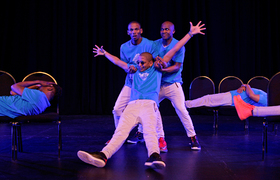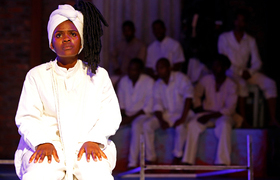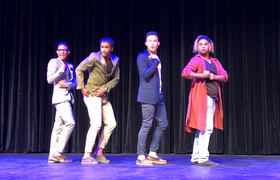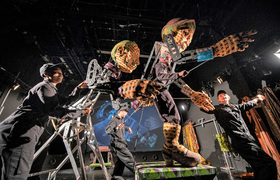PhD project weaves together narratives of slavery and incarceration
11 December 2019 | Story Nadia Krige. Photo Brenton Geach. Read time 7 min.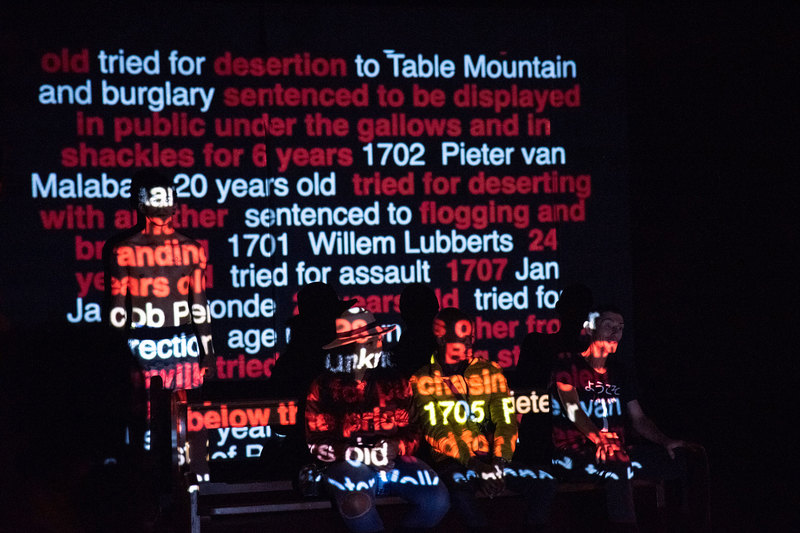
Despite its formative role in modern-day South Africa, the history of enslavement at the Cape has largely been eroded through the silencing of slave narratives. Facilitated by Javier Perez, a University of Cape Town (UCT) PhD candidate, Maroon is a poetic and performative collaboration that recovers the memory of runaway slaves and interrogates contemporary issues of crime, gangsterism and incarceration.
Perez’s interest in how the history of slavery haunts contemporary Cape Town was sparked back in 2013 when he visited South Africa as part of a Thomas J. Watson Fellowship. The one-year grant is awarded to select graduating seniors at 40 colleges throughout the United States (US) for purposeful, independent exploration outside the borders of the country.
Using his grant to explore the role of poetry in prisons, his travels took him to Brazil, Jamaica, Guatemala and, eventually, brought him to Cape Town.
“It was an incredible journey, but Cape Town really stole my heart more than anywhere else,” he said.
“I was very interested in the history and in the work that was being done.”
He found the poetry scene to be one of the most innovative he’d experienced and “really wanted to get involved with that”.
Perez – who grew up in the US state of Virginia and has family roots in El Salvador – decided that he wanted to conduct a more long-term, in-depth study in Cape Town and connected with Professor Ari Sitas within the Department of Sociology at UCT.
“Perez went about recruiting formerly incarcerated men who were interested in exploring their experiences through poetry, art and performance.”
He enrolled in a master’s degree under the supervision of Sitas and continued the research he had been doing around poetry in prisons, among other things running poetry workshops in Pollsmoor. In 2018, he was upgraded to a PhD.
“Of course, there were a lot of limitations working within a setting like that. So, I decided to start working with men who had been incarcerated but are now trying to make a life for themselves on the outside,” Perez said.
Working with formerly incarcerated men
This is where the idea for Maroon was sparked, which Perez described as “a three-month journey through intensive poetry and performance workshops at the Iziko Slave Lodge Museum with formerly incarcerated ʻcolouredʼ men”.
In its final expression, Maroon consisted of a stage production alongside an exhibition of the participantsʼ poetry, creative writing and photography. It was presented to the public at the Theatre Arts Admin Collective in Observatory between 3 and 5 December 2019.
With the help of a number of organisations, such as The Message who started the Gangstar Café in Mowbray to offer employment for ex-offenders, Perez went about recruiting formerly incarcerated men who were interested in exploring their experiences through poetry, art and performance.
The word-of-mouth recruitment process drew a lot of interest and Perez ultimately had five men who committed to participating in the process from start to finish.
While each of the men had different levels of theatre-making experience and a variety of skillsets, the one thing they all had in common was a wholehearted commitment to the project.
“They needed to be able to attend [twice] a week. But during some weeks it turned to three or four and, more recently, seven days a week,” Perez said.
“So, it was a huge commitment, but they were all in and it really worked out beautifully.”
“The more we did the poetry and performance, the more they saw themselves as artists.”
Interdisciplinary collaboration
Although Maroon forms part of Perez’s PhD, the project was a collaborative effort to its core with various facilitators joining at different phases of the three-month journey.
They included Nadjwa Damon from the Iziko Slave Lodge Museum; Jason Jacobs, professional theatre-maker and UCT master’s student; Jan-Louise Lewin from the African Gender Institute; and poet, performer and spoken-word educator Toni Stuart.
Since the project sought to seamlessly weave together the participants’ personal narratives with archival stories of maroons – fugitive slaves – who found refuge in the Cape mountains, the workshops took place at the Iziko Slave Lodge Museum.
“Because this study is about how the history is embodied, we also wanted to make sure that the bodies in question were within a space that invoked certain narratives and certain movements as well,” Perez explained.
Damon added immense value to this process, he said, by taking the participants on tours of various important historical sites of slavery in Cape Town to further develop these narratives. Another interesting aspect of the Maroon exhibition was the creation of body maps with Lewin.
“Body mapping is a feminist methodology so using that with men in this particular space was also very interesting,” Perez said.
Building on the poetry work Perez had been doing with the men, Stuart joined the project for a week of intensive workshops which explored writing around silences.
Maroon culminated in an exhibition of various artworks created during the three-month span of the project, as well as a theatre performance directed by Jacobs. He started the process by presenting a number of workshops after which they delved straight into creating the performance.
Even though most of the men had no prior experience in theatre-making, Perez said they outdid themselves in the performance.
“The more we did the poetry and performance, the more they saw themselves as artists.
“I’m extremely proud of what they’ve done and what they’ve accomplished. And to have been a part of this team, this group, it’s been one of the best experiences of my life.”
Reaching broader audiences
While the Maroon project has been wrapped up for now, both Perez and Jacobs see huge potential for taking the production forwards.
“I think the crisis and the issues of gangsterism and crime have not been addressed fully through the arts and through conversations of history.
“That, for me, is an important thing. The project is beautiful and needs to be seen.”
 This work is licensed under a Creative Commons Attribution-NoDerivatives 4.0 International License.
This work is licensed under a Creative Commons Attribution-NoDerivatives 4.0 International License.
Please view the republishing articles page for more information.







